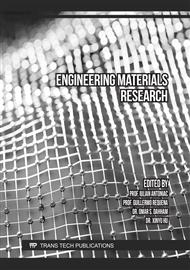[1]
K.L. Scrivener, R.J. Kirkpatrick, Innovation in use and research on cementitious material, Cement and Concrete Research. 28(2) (2008) 128-136.
DOI: 10.1016/j.cemconres.2007.09.025
Google Scholar
[2]
J. Deja, A. Uliasz-Bochenczyk, E. Mokrzycki, CO2 emissions from Polish cement industry, International Journal of Greenhouse Gas Control. 4(4) (2010) 583-588.
DOI: 10.1016/j.ijggc.2010.02.002
Google Scholar
[3]
A. Bougara, C. Lynsdale, K. Ezziane, Activation of Algerian slag in mortars, Construction and Building Materials. 23(1) (2009) 542-547.
DOI: 10.1016/j.conbuildmat.2007.10.012
Google Scholar
[4]
F. Bellmann, J. Stark, Activation of blast furnace slag by a new method, Cement and Concrete Research. 39(8) (2009) 644-650.
DOI: 10.1016/j.cemconres.2009.05.012
Google Scholar
[5]
J.I. Escalante, L.Y. Gómez, K.K. Johal, G. Mendoza, H. Mancha, J. Méndez, Reactivity of blast-furnace slag in Portland cement blends hydrated under different conditions, Cement and Concrete Research. 31(10) (2001) 1403-1409.
DOI: 10.1016/s0008-8846(01)00587-7
Google Scholar
[6]
M.A. Saafan, Z.A. Etman, Microstructure and durability of ground granulated blast furnace slag cement Mortars, Iranian Journal of Science and Technology, Transactions of Civil Engineering. 45(3) (2021) 1457-1465.
DOI: 10.1007/s40996-020-00533-3
Google Scholar
[7]
T. Bakharev, J.G. Sanjayan, Y.B. Cheng, Effect of elevated temperature curing on properties of alkali-activated slag concrete, Cement and Concrete Research. 29(10) (1999) 1619-1625.
DOI: 10.1016/s0008-8846(99)00143-x
Google Scholar
[8]
X. Wu, W. Jiang, D.M. Roy, Early activation and properties of slag cement, Cement and Concrete Research. 20(6) (1990), 961-974.
DOI: 10.1016/0008-8846(90)90060-b
Google Scholar
[9]
D. Krizan, B. Zivanovic, Effects of dosage and modulus of water glass on early hydration of alkali–slag cements, Cement and Concrete Research. 32(8) (2002) 1181-1188.
DOI: 10.1016/s0008-8846(01)00717-7
Google Scholar
[10]
Y. Zuo, M. Nedeljković, G. Ye, Pore solution composition of alkali-activated slag/fly ash pastes, Cement and Concrete Research. 115 (2019) 230-250.
DOI: 10.1016/j.cemconres.2018.10.010
Google Scholar
[11]
T. Bakharev, J.G. Sanjayan, Y. Cheng, Alkali activation of Australian slag cements, Cement and Concrete Research. 29(1) (1999) 113-120.
DOI: 10.1016/s0008-8846(98)00170-7
Google Scholar
[12]
S.D. Wang, K.L. Scrivener, P.L. Pratt, Factors affecting the strength of alkali-activated slag, Cement and Concrete Research. 24(6) (1994) 1033-1043.
DOI: 10.1016/0008-8846(94)90026-4
Google Scholar
[13]
H. Lahalle, V. Benavent, V. Trincal, T. Wattez, R. Bucher, M. Cyr, Robustness to water and temperature, and activation energies of metakaolin-based geopolymer and alkali-activated slag binders, Construction and Building Material. 300 (2021) 124066.
DOI: 10.1016/j.conbuildmat.2021.124066
Google Scholar
[14]
K.C. Reddy, K.V.L. Subramaniam, Blast Furnace Slag Hydration in an Alkaline Medium: Influence of Sodium Content and Sodium Hydroxide Molarity, Journal of Materials in Civil Engineering. 32(12) (2020) 04020371.
DOI: 10.1061/(asce)mt.1943-5533.0003455
Google Scholar
[15]
B.S. Gebregziabiher, R.J. Thomas, S. Peethamparan, Temperature and activator effect on early-age reaction kinetics of alkali-activated slag binders, Construction and Building Materials. 113 (2016) 783–793.
DOI: 10.1016/j.conbuildmat.2016.03.098
Google Scholar
[16]
F. Puertas, T. Amat, A. Fernández-Jiménez, T. Vázquez, Mechanical and durable behaviour of alkaline cement mortars reinforced with polypropylene fibres, Cement and Concrete Research. 33(12) (2003) 2031-2036.
DOI: 10.1016/s0008-8846(03)00222-9
Google Scholar
[17]
J. Goncalves, M. El-Bakkari, Y. Boluk, V. Bindiganavile, Cellulose nanofibres (CNF) for sulphate resistance in cement based systems, Cement and Concrete Composites. 99 (2019) 100–111.
DOI: 10.1016/j.cemconcomp.2019.03.005
Google Scholar
[18]
N.A.M. Beltrame, C.A. da Luz, M. Perardt, R.D. Hooton, Alkali activated cement made from blast furnace slag generated by charcoal: Resistance to attack by sodium and magnesium sulfates, Construction and Building Materials. 238 (2020) 117710.
DOI: 10.1016/j.conbuildmat.2019.117710
Google Scholar
[19]
A. Pereira, J.L. Akasaki, J. L. Melges, M.M. Tashima, L. Soriano, M.V. Borrachero, J. Monzó, J. Payá, Mechanical and durability properties of alkali-activated mortar based on sugarcane bagasse ash and blast furnace slag. Ceramics International, 41(10) (2015) 13012-13024.
DOI: 10.1016/j.ceramint.2015.07.001
Google Scholar
[20]
L. Jianyong, Y. Yan, A study on creep and drying shrinkage of high performance concrete, Cement and Concrete Research. 31(8) (2001) 1203-1206.
DOI: 10.1016/s0008-8846(01)00539-7
Google Scholar
[21]
P. Awoyera, A. Adesina, A critical review on application of alkali activated slag as a sustainable composite binder, Case Studies in Construction Materials. 11 (2019), e00268.
DOI: 10.1016/j.cscm.2019.e00268
Google Scholar
[22]
T. Ayub, N. Shafiq, S.U. Khan, M.F. Nuruddin, Durability of Concrete with Different Mineral Admixtures: A Review, International Journal of Civil, Environmental, Structural, Construction and Architectural Engineering. 7(8) (2013) 265-276.
Google Scholar
[23]
M. Vafaei, A. Allahverdi, P. Dong, N. Bassim, M. Mahinroosta, Resistance of red clay brick waste/phosphorus slag-based geopolymer mortar to acid solutions of mild concentration, Journal of Building Engineering. 34 (2021) 102066.
DOI: 10.1016/j.jobe.2020.102066
Google Scholar


